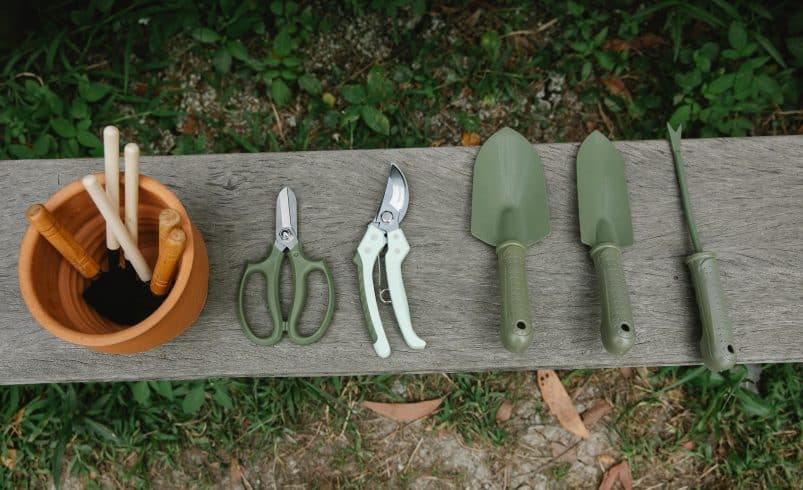According to the National Association of Landscape Professionals, 90% of Americans believe maintaining their yard is important, yet many feel overwhelmed by the process. I’ve spent years helping homeowners find the right tools to simplify their weekend landscaping projects. Whether you’re a novice gardener or a seasoned DIY enthusiast, having the right tools can make all the difference between a challenging chore and an enjoyable outdoor project.
Essential Hand Tools for Basic Yard Maintenance
The foundation of effective yard maintenance begins with reliable hand tools. A professional-grade hand trowel stands as the cornerstone of any gardening toolkit, featuring a sturdy stainless steel blade and ergonomic handle for precise digging, transplanting, and soil management. The curved blade design allows for efficient soil movement, while the pointed tip excels at breaking up compacted earth.
Pruning shears represent another critical tool, with bypass pruners being particularly effective for live plant material. Quality pruners should feature hardened steel blades, comfortable grip handles, and an adjustable tension mechanism. These tools enable precise cuts up to half an inch in diameter, maintaining plant health while promoting new growth.
Hand rakes come in various styles, each suited to specific soil conditions. Fan rakes with flexible tines work best for leaf collection and lawn maintenance, while bow rakes with sturdy steel tines excel at soil preparation and gravel spreading. For sandy soils, wider-spaced tines prevent clogging, while closer tines suit clay-based gardens.
An ergonomic garden spade makes heavy digging tasks manageable through thoughtful design elements. Key features include a D-shaped handle for improved grip, a slightly curved blade for better soil penetration, and a reinforced step plate to protect boots during deeper digging operations.
Multi-purpose weeding tools combine efficiency with versatility. The hori-hori knife, for instance, serves as both a weeder and a planting tool, while the Cape Cod weeder excels at removing weeds from tight spaces between plants.
Power Tools That Save Time and Energy
Battery-powered leaf blowers have revolutionized yard maintenance with their combination of power and portability. Modern lithium-ion batteries provide extended runtime while eliminating the noise and maintenance associated with gas-powered alternatives. Variable speed controls allow for precise cleaning of both delicate garden beds and stubborn leaf piles.
Cordless string trimmers offer unprecedented freedom of movement around the yard. Advanced models feature adjustable cutting widths, automated line feeding systems, and ergonomic design elements that reduce operator fatigue. The elimination of power cords and gas engines makes these tools particularly suitable for properties with numerous obstacles or landscaping features.
Electric hedge trimmers have evolved to include features like dual-action blades for reduced vibration, wrap-around handles for multiple cutting angles, and safety locks to prevent accidental activation. Blade lengths typically range from 16 to 24 inches, with tooth spacing designed for specific branch sizes.
Compact lawn mowers now incorporate smart features while maintaining manageable sizes for storage. Key considerations include cutting height adjustment mechanisms, grass collection systems, and folding handles for vertical storage. Electric models eliminate the need for fuel storage while providing sufficient power for typical suburban lawns.
Smart Storage Solutions for Your Tools
Wall-mounted tool organizers maximize vertical space while keeping tools visible and accessible. Systems range from simple pegboard configurations to specialized tool holders with protective coatings to prevent rust transfer. Magnetic strips prove particularly useful for smaller metal tools.
Mobile tool carts transform yard maintenance by bringing tools directly to work areas. Key features include all-terrain wheels, multiple compartments for organization, and weather-resistant construction. Some models incorporate built-in tool maintenance stations with cleaning supplies and sharpening equipment.
Weather-resistant storage options protect valuable tools from environmental damage. Climate-controlled tool sheds, waterproof storage containers, and rust-prevention systems extend tool life significantly. Proper ventilation prevents moisture accumulation while maintaining tool integrity.
Tool maintenance stations centralize cleaning, sharpening, and repair activities. Essential components include a sturdy workbench, adequate lighting, and specialized maintenance tools. Regular maintenance schedules help prevent tool deterioration and ensure optimal performance.
Budget-Friendly Tool Alternatives
Multi-purpose tool combinations reduce initial investment while maintaining functionality. Convertible tools with interchangeable heads serve multiple purposes, while carefully selected multi-tools replace several individual implements. This approach maximizes utility while minimizing storage requirements.
The decision between renting and purchasing depends on factors like usage frequency, storage availability, and project scope. Seasonal tools often prove more economical to rent, while frequently used items justify purchase investments. Clear project planning helps identify the most cost-effective approach.
Second-hand tool shopping requires careful evaluation of tool condition and potential restoration needs. Key inspection points include handle integrity, blade sharpness, and moving part functionality. Many quality tools can be restored to nearly new condition with proper maintenance.
Innovative Tools for Specific Projects
Mulch spreading equipment ranges from basic spreading forks to specialized wheeled dispensers. Advanced options include adjustable spread patterns and depth control mechanisms. These tools significantly reduce the time and effort required for proper mulch application.
Border edging tools have evolved to include guided cutting systems and adjustable depth controls. Manual edgers provide precise control for detailed work, while powered edgers excel at maintaining longer borders. Some models incorporate multiple cutting angles for various edging styles.
Plant spacing markers eliminate guesswork in garden planning and maintenance. Options include adjustable spacing guides, pre-marked templates, and laser-guided systems for precise placement. These tools ensure optimal plant distribution and growth conditions.
Soil testing equipment provides crucial data for maintaining healthy gardens. Professional-grade pH meters, nutrient testing kits, and moisture sensors help optimize growing conditions. This information guides fertilization and watering decisions throughout the growing season.
Water management tools have become increasingly sophisticated, incorporating smart technology for efficient irrigation. Modern options include programmable timers, moisture-sensing shutoffs, and zone-specific watering controls. These systems optimize water usage while maintaining plant health.
Your Weekend Project Toolkit
Remember, successful weekend landscaping starts with the right tools. By investing in these essential items, you’ll save time, reduce physical strain, and achieve professional-looking results. Start small, build your collection gradually, and watch your outdoor space transform with each project.













